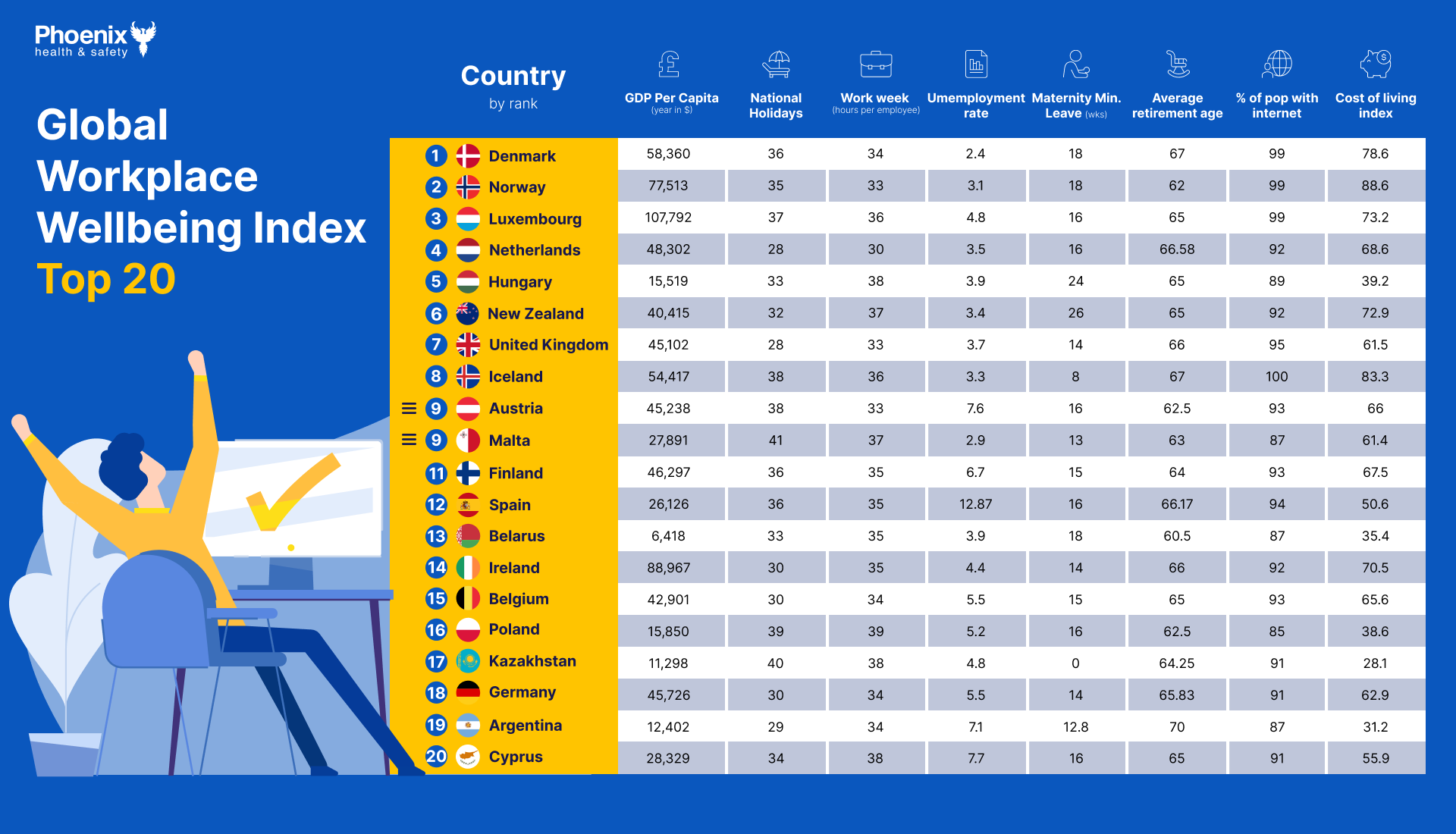Global Workplace Wellbeing Index

The Importance of Workplace Wellbeing
In recent years, workplace wellbeing has become an increasingly important topic for employers to consider as part of the overall running of the business. The COVID-19 pandemic highlighted the importance of employee mental and physical health, as many struggled to cope with the challenges brought on by the pandemic, including remote work, social isolation, and increased stress.
This has resulted in a growing recognition that workplace wellbeing is not only important for employees' personal health and happiness, but also their satisfaction and engagement with their work. A workplace that prioritises employee wellbeing creates a supportive and healthy work environment where employees feel valued, respected, and empowered.
This, in turn, can lead to a range of benefits, including improved productivity, reduced absenteeism, and increased employee retention.
The Best Countries for Workplace Wellbeing
Employee wellbeing can be impacted by a variety of factors, including the work environment, job demands, and work-life balance, as well as several considerations outside of the immediate workplace. To understand which countries offer their employees the best chance at workplace wellbeing globally, we have analysed eight areas of importance to staff wellbeing and compared them internationally.
Analysing a range of influencing factors such as how many national holidays are on offer to employees, the country’s unemployment rates and the average retirement age, alongside lifestyle factors such as where the country sits in the Cost of Living Index, the percentage of population with access to the Internet and the GDP per capita, we have been able to determine the top 20 countries for employee wellbeing.

Denmark was revealed to be the country with the best workplace wellbeing overall, with one of the lowest unemployment rates globally, at just 2.4%, an average working week of 34 hours, and a minimum of 18 weeks of paid maternity leave for employees.
Following Denmark is Norway with an average retirement age of 62, and Luxembourg with its allowance of 37 holidays. In seventh place is the United Kingdom. With 28 days of statutory leave entitlement, a minimum of 14 weeks of paid maternity leave, and an average working week of 33 hours, employees in the UK enjoy some of the highest workplace wellbeing in Europe.
The Contributing Factors to Workplace Wellbeing
Workplace wellbeing is not just the responsibility of individual employees, but also of the organisation as a whole. Employers have a duty to create a workplace culture that supports employee wellbeing and provides the necessary resources and support for employees to thrive.
Here we take a closer look at the individual ranking factors analysed, and why they are important areas to consider when it comes to the overall wellbeing of employees.
GDP per capita

The GDP per capita can have an indirect impact on employee wellbeing by influencing the country’s economic conditions, which will shape a workplace’s environment. When the economy is doing well, there tend to be more job opportunities, higher wages, and greater investment in healthcare and social services, which can create a more stable and supportive environment that promotes employee wellbeing.
Luxembourg leads the charge with the highest GDP globally, at $107,792, followed by Ireland ($88,976) and Switzerland ($87,340). It’s worth noting that GDP per capita does not take into account important factors such as income equality, social welfare or environmental quality, but does remain a useful tool for comparing the living standards globally.
National Holidays and Annual Leave
National holidays are special days that are usually decided by a country's government to commemorate or celebrate important historical, cultural, or religious events or figures. Often this will mean that non-essential businesses can close for the day to allow employees the opportunity to celebrate the national holiday with friends and families. The figures are combined with the minimum annual leave allowance per country to give the total number of paid days off employees can take.
Iran offers employees the most holidays of all the countries analysed, with 53 national holidays observed each year. Following Iran are Andorra, Cambodia and Burkina Faso, which each offer 45 national holidays, and Bahrain with 44 holidays observed.
Working week hours

National working time regulations differ quite a bit across the world, but ultimately are designed to protect workers' rights, promote work-life balance, and ensure health, safety, and well-being, while also ensuring that they have adequate time for rest and leisure. By promoting a better work-life balance, these factors help to support a more satisfied workforce, and a healthier work environment.
While the four-day week continues to be a hot topic in the UK, it seems many countries have successfully transitioned to a shorter working week. The Netherlands is home to the shortest working week, where employees work an average of 30 days each week (the same as in Iran), while in the UK that number is only slightly higher at 33 hours per week.
Thanks to the Working Time Directive, EU member states must ensure that workers are not required to work more than an average of 48 hours per week, including overtime. In comparison, workers in the Middle East are guilty of the longest working weeks, with employees in countries like the UAE, Oman and Bahrain all working an average of 55 hours per week.
Unemployment rate
The unemployment rate can have a significant impact on workplace wellbeing, both for those who are currently employed and for those who are seeking employment. When unemployment rates are high, workers may feel more anxious about the stability of their own jobs. This can lead to increased stress, lower job satisfaction, and a general sense of insecurity in the workplace.
Our analysis shows that while Qatar has the lowest unemployment rate globally, with 0.1% of the population out of work, it’s Nigeria that has the largest number of unemployed people, with a third of the population out of work.
Employers should attempt to support their workers during periods of economic instability, whether that be through offering mental health resources, flexible work arrangements, additional training or other benefits that can help to alleviate stress and support employees' overall wellbeing.
Maternity leave
The offer of paid maternity leave beyond any statutory benefits offered by the government can rightly impact an employed parent’s overall wellbeing. Not only does the offer of paid time off to bond and care for a new child give employees job security, but it also promotes diversity and staff retention.
In New Zealand, new mothers are offered a minimum of 26 weeks of paid maternity leave to spend with their new child, the highest maternity leave package within the analysis. Hungary is not far behind with a minimum of 24 weeks of maternity leave available, followed by Italy with 20 weeks of paid leave available for pregnant employees.
In contrast, countries like the United States, Lithuania and Latvia currently have no maternity leave allowances available to their employees, forcing them to consider alternative options when having a baby.
Retirement age

The average age of employees when they choose to retire can impact workplace wellbeing in that it serves to advise the current workforce how many years they can expect to be working in their lifetimes. For employees whose wellbeing is not being considered by the employer, the prospect of working well into old age might be something that causes additional stress.
China, Mongolia and Uzbekistan have the youngest average retirement age, with the majority of employees giving up work at the age of 57.5. In contrast, many African and South American countries require employees to continue working up to an average retirement age of 70 years old.
While older employees bring experience and loyalty to a business, their physical and mental health requirements will be far more serious than younger employees and workplace wellbeing programs will need to adapt to those specific needs.
% of the population with internet
Access to the internet is now almost as important as access to clean and running water to most employees. Without the internet to communicate, research and learn, plan routes and connect with colleagues, employees are limited to a fairly insular workplace where overall wellbeing will be limited to physical, in-person activities.
The Middle East has the largest percentage of the population with access to the internet, with 100% of people in countries like Qatar, Bahrain and the UAE connected in some way. Europe also has a large percentage of its population online, with 99% of people in countries such as Denmark, Luxembourg and Norway connected to the internet. The UK has 95% of the population with access to the internet, the same as Oman and Brunei.
Cost of living index rank

While the cost of living continues to rise in many parts of the world, the knock-on effects can be seen outside of household budgets. As costs rise, employees may find it more difficult to make ends meet, which can cause significant financial stress which in turn can spill over into the workplace, causing decreased productivity, increased absenteeism, and lower overall job satisfaction.
Employers may need to offer higher wages and better benefits to help employees where possible, in order to keep up with the cost of living. If they don't, employees may feel that their wages are inadequate and may become disengaged from their work. Additionally, if a benefits package is not competitive – both financially and from a health and wellbeing perspective, employees may be more likely to seek employment elsewhere.
For help assessing your business’ workplace wellbeing, take a look at the range of courses available through Phoenix Health & Safety.
-----
Methodology
The Global Workplace Wellbeing Index is made up of eight key data sources which are amalgamated and weighted into a points-based scoring system where the data was available for 195 countries. Due to the conflict between Ukraine and Russia, Russia has been removed from the index.
Index sources:
GDP - Trading Economics: GDP and Average income around the world
National holidays - List of minimum annual leave by country
Average working week - Average Workweek by Country 2023
Unemployment rate - Trading Economics: unemployment rate
How much maternity leave - ILO: More than 120 Nations Provide Paid Maternity Leave
Retirement age - Trading Economics: Retirement Age Men and Trading Economics: Retirement Age Women
% of population with internet - Individuals using the Internet (% of population)
Cost of living index by country- Cost of Living Index by Country 2023
References:
Working Time Directive: Maximum weekly working hours - gov.uk